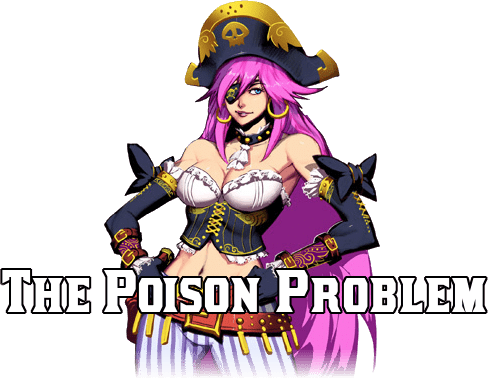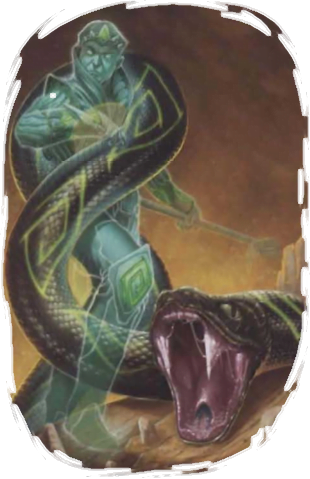
I love me some 4th Edition D&D and it’s a well known fact I love complaining about things, so one might wonder why I didn’t do both at once. Well, for a start, I find that most complaints about 4ed D&D are pretty wrongheaded, usually building around nebulous ideas of ‘feel’ or ‘style’ and acting as if it was bad that a game did what the game was trying to do. That isn’t to say, though, that I think 4ed D&D is a flawless system by any means, and as if to prove it, let’s talk about a really stupid decision it has going on.
In 4ed D&D the damage type system and resistance system is pretty solid. The rules, almost always, work the same way and you don’t – mostly – have any oddness. The damage types are not created equal by any means: Necrotic has to run headlong into a lot of resistances, and Radiant is overwhelmingly well supported (and we can get into uneven support another time, but that is also a problem with 4th Ed). The point is that mostly, damage types were created equal.
Except Poison.
Poison, in 4ed D&D had the special clause that any creature immune to poison damage was also immune to all effects of any power with the poison keyword. This kind of makes sense: poisons, as represented by like, toxins you put in people’s drinks, shouldn’t be affecting you if the poisons themselves don’t hurt you, right?
The problem is this rule is extremely rarely going to come up: Poisons as a tool in D&D were really inconvenient and there’s very little way to use poisons the thing. There is, however, a handful of powers that have poison effects , and a surprising number of enemies who are immune to poison as a sort of throw-in effect. Most undead, for example, couldn’t be poisoned. And okay, it is probably okay that enemies can’t be forced to choke and gag in a Poison Cloud power, fine, buuuut…

Here’s the art for the Coiled Serpent paragon path for the Druid. When Druids like this are in their beast forms, they do extra poison damage. What that means is that at level 15, your Savage Rend deals its damage and slides an enemy… but at level 16, your savage rend still does the same damage (they’re not immune to all of it), but don’t get slid any more.
This is pretty silly, and there’s not really an obvious or easy fix to it with the rules as written. The easiest way I can see it is to separate Poison Damage Type on powers from Poisons, the things you put in strangers’ foods.
It’s a corner case, but when you consider that the druid paragon paths are pretty limited in their application (thanks to splintering, which I’ll discuss another time), if you want to do more damage with your paragon path, this one is one of two options, and it’d be fine… except for that oddball clause that means, as a controller, all your secondary effects on your powers stop working once you have the path.
This article was reposted from Talen’s personal blog.
You can find the original at Press.exe

3 Comments
I’m having trouble finding the rule you mention, but as you describe it, the problem with the paragon path you mention doesn’t occur, per the rules. The druid adds extra poison, but the power that is adding that poison doesn’t gain the Poison keyword. Which makes sense, because the poison is just added, it’s not the source of the other effects of the power. I thought there was a general rule about powers gaining the keyword if their damage type changes, but I can’t find it at the moment. But even if there is one, this isn’t a case of that, because it’s not “all damage dealt by the power is poison.” And even in /that/ case, I’d be surprised if there wasn’t an item that let the druid change all its damage to another type. Which, come to think of it might be a useful approach for monsters that would get shut down by poison resistance: find a way to add another keyword to their power. Like, I don’t know, radiant?
Another way to address this would be how I see it handled in the game Sentinels of the Multiverse (the card game anyway). If an effect is intended to be tied to the damage in such a way that not taking the damage should negate the effect then the power says “A target that takes damage this way, etc…” Like if a power is a poisonous bite that dazes, then it would say “if the target takes damage from this power, they are dazed (save ends)” but if it’s a poisonous bite that grabs it wouldn’t say that and a target could avoid the poison damage, but still be grabbed.
The rule on adding damage type keywords is in the PHB errata, and later in the Rules Compendium:
“If the damage types in a power change, the power both loses the keywords for any damage types that are removed and gains the keywords for any damage types that are added (the poison keyword is removed from a power only if that power neither deals poison damage nor has any nondamaging effects).”
…And the immunity to non-damaging effects rule is in the Rules Compendium:
“If a creature is immune to charm, fear, illusion, or poison, it is unaffected by the non-damaging effects of a power that has that keyword.”
Personally I think it’s just an oversight, because poison is uniquely both a damage type /and/ a non-damage keyword. (I also did an article on this one, with the goal of suggesting errata.) But whether or not it’s intentional, it does—assuming you are playing with the most current ruleset including errata—pretty clearly work as Talen describes.
I hadn’t noticed before, but hilariously, that errata passage makes the poison keyword /extra/ hard to remove, even with a global damage override…
I see, thanks. Yeah, that’s unfortunate and, yeah, probably an oversight. If organized 4th Edition play were a thing, I’d want them to fix this as it seems abuseable in addition to problematic, but it also seems like something a conscientious table can figure out for themselves.